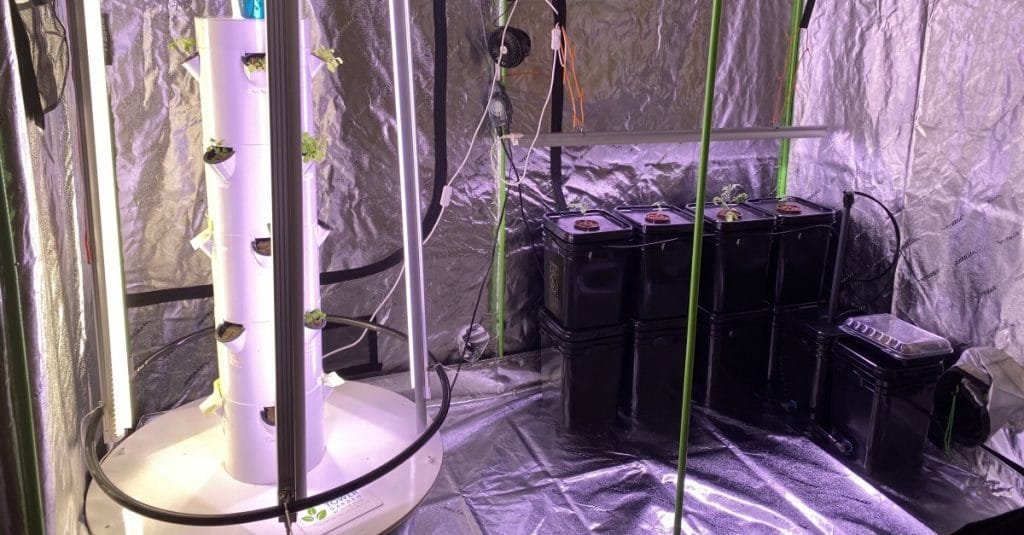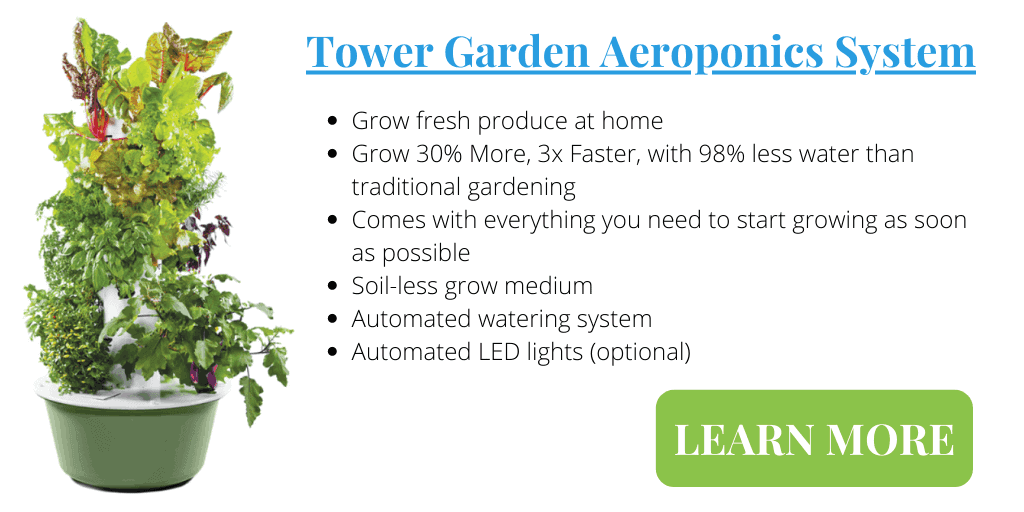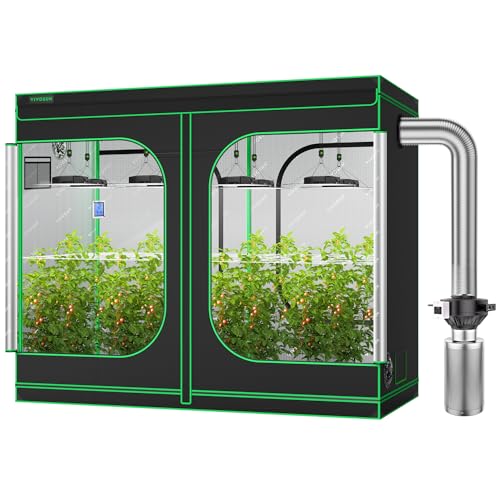When selecting the best grow lights for your grow tent, choose a fixture that operates efficiently without producing a lot of heat and one that provides the proper coverage of the canopy and undergrowth. Full spectrum lights best mimic the sun’s natural light and provide the best color for strong growth and flowering.
The best grow lights to use in a grow tent are LED grow light panels or LED T8 strips. LED grow lights are the most energy efficient fixtures and are able to provide the full spectrum of colors that plants need to grow and flower. LEDs produce less heat keeping your tent cooler and they cost less to operate for the same light output as other grow light types.
I’m outlining what I consider to be the best two options for grow tent grow lights below. Depending on the setup of your tent you will have great success using one or combining both the Spider Farmer SF4000 and Barrina T8 LEDs together.

The Best Grow Tent LED Light Panel
Spider Farmer SF4000 LED Grow Light
The SF4000 is a 480 watt full spectrum LED grow light panel with a 3’x5’ coverage for veg or 2’x4’ for flowering plants. Using the highest quality Samsung LM301B diodes, the dimmable grow light panel uses half the power as comparable models consuming only 202 watts.
The latest design changes to the LED layout concentrate more diodes along the outer edge of the fixture to create a more uniform photon density coverage. The new configuration ensures the blue, red and IR spectrum is distributed across your grow space regardless of whether your plants are in the growth or flowering stages of their life cycle. This helps your crop to grow fast while providing a natural light effect making it easier to identify common plant problems with your home garden.
The fanless Mean Well driver has an all aluminum heat sink to dissipate heat efficiently helping to extend the lifespan of the grow light fixture. Multiple panels can be daisy chained together to provide smoother control over the entire lighting system with the dimmer control knob.
- Cutting-Edge LED Chips for Unrivaled Performance:Introducing the Samsung LM301H EVO LEDs....
- 5-Year Warranty: Our LED Plant Lights are often copied but will never have our quality or...
- Ideal For All Growth Stages: Excellent full spectrum- white, blue, red and IR (3000K, 5000K,...
Best LED Grow Light Tubes For Grow Tents
Barrina T8 LED Grow Lights
These 42 watt full spectrum grow lights are perfect for starter and hobbyist gardeners like many of us. They are very affordable and energy efficient.
These lights provide enough PFFD to grow greens, tomatoes, cucumbers, strawberries and herbs in my 4×8 grow tent without putting a dent in my electric bill.
The 6 fixture pack of 4ft T8 LED tubes is a combined 252 watts and provides a light density equivalent to a 1400 watt traditional grow lamp. The design of the fixture incorporates slots for easy mounting of the reflectors to increase the light efficiency.
The package includes lots of extra cords, switches and mounting hardware to make setup fast and simple. I use the factory made daisy chain cords to connect my lights into 2 separate circuits that operate 4 to 6 lights off a single timer outlet.
- Full Spectrum: Barrina LED grow lights 4ft provide indoor plants with full-spectrum sunlight...
- Super Bright and High PPFD: Consuming only 252W with 1152 LEDS totally, replace 1400w general...
- Easy Installation: With included tape, clips and cable ties, you could install the lights by...
Using 4ft LED light strips gives better customization options when it comes to mounting my lights relative to my fruits, veggies and herbs. I use these Barrina lights mounted across the ceiling and hanging vertically around my Tower Garden. I’ve even mounted them horizontal across the tent side rail for extra light coverage under the canopy.

What Makes A Grow Light Good For A Grow Tent?
Knowing whether or not a grow light suits your tent is determined by a few metrics:
- The dimensions of the tent and light fixtures,
- Wattage and heat generated by the grow lights
- Varieties of plants you are planning to grow.
The factors that make a grow light good are all relative to the grow tent or grow room you are using and its efficiency in providing the proper levels of lighting to your plants. No single grow light will suit every growing space.
Here’s my full guide to lighting solutions for your home hydroponic garden.
Dimensions of Grow Tent Lighting
Most grow lights are manufactured as straight tubes of fluorescents, LED strips, or as a flat panel of LED lamps. Other designs include circles, ladder panels and traditional bulbs. Each has its own design purpose and application.
The dimensions of square and rectangular light fixtures are standardized as 12”, 24” and 48” lengths and widths. This size is ideal for grow tent dimensions which are similarly sized with 24”, 36”, 48” and 96” sides.
Be aware that a 48” light fixture will fit a 48” grow tent but if the power cord connects at the end it will be pressing against the side of the tent. It hasn’t caused any issues in my grow tent.
The dimensions of a grow light are clearly marked on the packaging to help assess whether it will fit your tent and how it will work in conjunction with your other lights and ceiling mounted equipment.
The weight of the grow light may become a problem if the frame of your grow tent is not strong enough to support it. Commonly grow lights are suspended from the ceiling frame poles above the grow space. They can be raised and lowered to the ideal height above the plant tops.
Wattage, Efficiency and Heat From Grow Lights
High wattage grow lights can create a lot of heat inside a grow tent which needs to be vented using an exhaust fan and duct. The high powered electronics and fixture ballast convert a lot of electricity into heat if they are not efficient.
Many low wattage LED lamps that provide color spectrum of Blue, Red, Green and even IR ranges are more efficient at creating electricity into light with less heat produced. Fluorescent lights operate efficiently as well but lack the range of spectrum offered by LED technology.
An exhaust fan can be mounted inside or outside your grow tent and is commonly hanging from the frame poles at the top of the tent. The warmer air rises to the top of the tent and fresh air can be provided using the vents along the bottom of the side walls.
Here’s some information on grow tent safety and avoiding fire and damage.
Grow Light Cooling System
High powered lights can have an active cooling system like built in fans or a passive cooling system like a large heat sink. This is to keep the heat generated by the fixture from causing damage to the onboard electronic components including the diodes. Heat is a byproduct of converting electricity to light and is considered an inefficiency of the light.
The heat generated by grow lights is minimized in many LED and fluorescent fixtures but large ballast lights like HM and HPS lights create a lot of heat loss. This can create a swing in temperature inside a grow tent and the extra heat will need to be exhausted to the exterior of the tent.
Grow tents can be purchased online as kits which include the lights, ducting, inline fan, carbon filter and more. These kits are designed to provide the proper amount of lighting and air flow for the tent size.
- Keeps All Light Inside: The VIVOSUN Hydroponic Mylar Grow Tent is made of high-quality 600D...
- Low Costs & High Efficiency: VIVOSUN VS4000 LED grow light uses Samsung LM301 diodes & brand...
- Powerful Air Flow: Heavy-hitting blower with a fan speed of 2450 RPM; Puts out only 50 dB noise...
Color Spectrum of Grow Lights
The color spectrum of grow lights varies by lighting type and manufacturer. Fluorescent, Metal Halide, and some LEDs are in the blue light spectrum which is good for plant growth in the vegetation cycle of life.
High pressure sodium and special LED chips operate in the red spectrum which is best for the flowering and fruiting phase of the plant’s life.
Full spectrum LED grow lights combine red, blue, and some infrared wavelengths because those are the ones that most benefit the plants of an indoor garden. Using a white lamp makes it easier to identify plant disease and insect issues early compared to a blue, red or purple light.
Here’s my recent post with more information on why grow lights are red and blue.
Grow Light Coverage
The light coverage refers to the area that a single grow light can properly illuminate at a given intensity. This measurement is typically given in square feet. For instance, one grow light will illuminate a 2 foot by 2 foot area properly, but others can illuminate a 4 foot by 4 foot area. This means you have to know the coverage needed for the area of your grow room.
Operating Conditions and Ratings
Depending on what you are growing, your lights will experience varying amounts of moisture or humidity, and it goes without saying that water and electricity are not a good combination. Grow lights, electronic timers, extension cords all have a UL, CSA, or equivalent waterproof rating to prevent damage to your body and your equipment.
What is The PPFD of a Grow Light
The PPFD is the Photosynthetic Photon Flux Density of the grow light. It’s a lot of fancy words to describe how much light energy the grow area gets per meter every second. A higher PPFD will provide light for more plants in the same area.
The density reduces as the fixture gets further away from the plants because the flux rays spread out more providing less light energy per meter every second.
My latest post goes further in depth about how many grow lights do you need for growing food indoors.
Are White Grow Lights Good For A Grow Tent?
White grow lights are generally regarded as the best choice of grow light because they can emit the full spectrum of light. While it is known that almost all plants absorb the blue wavelength and the red wavelength the most, this does not mean that plants can only absorb these colors.
Although plants absorb the colors blue and red the most, they tend to grow better, faster, and more robust when provided with the full spectrum that white grow lights emit. White light is the best light to use in a grow tent due to the full spectrum of color provided, making this a good substitute for the sun.
No matter how you grow your plants or what plants you are growing, if you are growing indoors or in a grow tent, the indisputable fact is that you have to use a grow light to play the part of the sun.
There are reasons why people choose red, purple, and blue spectrum lights over traditional white lights. Here’s my recent article that explains why grow lights are purple.
Do LED Strip Lights Help In A Grow Tent?
LED strip lights do not produce a significant enough amount of light to help grow any plant effectively, even when in a grow tent with reflective paneling. The only organism that LED strip lights may aid to grow well is edible and medicinal fungi.
The unfortunate reality of the matter is that due to the low output wattage of LED strip lights, they cannot produce the amount of light required to cause photosynthesis to occur in a plant. In a grow tent, the use of LED strip lights may help by adding more blue and red wavelengths to the color spectrum the plants receive from the main grow light.
When looking at LED strip lights, you know that they are great for livening up a party or bringing a cool look to a bedroom. However, growing a plant is not what they are designed for.
Ever wonder can any LED light can be a grow light?
How Far Should The Grow Lights Be From The Plants?
The distance between the top of the plant’s canopy and the grow light is determined by three factors.
Wattage Helps Determine Grow Light Height
The wattage of the grow lights will determine how far from the plants they can be while still providing the light intensity plants need to grow. A higher wattage light can be positioned higher and therefore cover more area than a lower wattage Light. But don’t be fooled, wattage isn’t everything.
- If the grow lights wattage is 100w to 199w, you have to keep the grow lights between 8 inches and 12 inches away from the top of the plans.
- With grow lights that are roughly 200w to 399w, the height increases to between 12 inches and 20 inches away from the top of the plans.
- With lights that are approximately 400w to 599w in strength, the lights need a height of between 20 inches and 30 inches away from the top of the plans.
- All lights over 600w have to be 30 inches or more away from the top of the plant or plants to prevent burning the leaves and damaging the plants.
Plant Size And Grow Light Height
The age of the plants will affect how far away the lights have to be. Younger seedlings need the light to be close to prevent them from shooting up too quickly. A low wattage light should be used in the seedling stage to prevent burning the tops of the juvenile plants.
Older and more established plants have more foliage and stronger stalks so the light can be further away overhead of the plant crowns. Placing the light closer to the plants is more efficient because no light is lost to the environment like when it’s mounted higher up.
Directing Grow Lights For More Efficiency
The reflective sidewalls, ceiling and floor of a grow tent redirects the stray lighting in the tent back to the undergrowth and smaller plants growing in the garden. The increased reflected light allows the grow light to cover more area.
Light hoods and reflectors help to direct the lights and narrow the spread of the light beam from the light fixture. Using a hood increases the efficiency of your grow light by a large margin.
Which Is Better T8 LED Or T8 fluorescent Grow Lights?
T8 LED grow lights exceed the capabilities of a T8 fluorescent grow light. T8 LED grow lights burn at a lower temperature, have a longer lifespan, and don’t contain potentially harmful gasses. High quality T8 LED lights emit the full color spectrum, and draw half as much power as a T8 fluorescent grow light of the same effectiveness.
As grow light technology has advanced over the years, debates have started to arise about what type of grow light is better for growing plants successfully indoors or in a grow tent. No matter what, everyone will still have their own opinion.
The advancements in technology have made LED’s cheaper to buy and operate and more effective at producing light to mimic natural sunlight. This has increased their popularity to surpass the use of traditional T8 Fluorescents with many growers.
Both T8 LED, and T8 fluorescent grow lights are excellent at increasing plant growth without using a lot of electricity producing the light. To allow you to make up your mind about which grow light is better for your needs, here is a side by side table of a 2 x 4 foot T8 LED and 2 x 4 foot T8 fluorescent grow lights.
| Criteria | LED | Fluorescent |
| Surface Temperature | Roughly 103℉ | Roughly 140℉ |
| Lifespan | 60,000 Hours | 20,000 Hours |
| Gases | Non | Mercury and argon gas |
| Light spectrum | Full | Full |
| Power Draw | 92w | 205w |
- Full Spectrum: Barrina LED grow lights 4ft provide indoor plants with full-spectrum sunlight...
- Super Bright and High PPFD: Consuming only 252W with 1152 LEDS totally, replace 1400w general...
- Easy Installation: With included tape, clips and cable ties, you could install the lights by...
Conclusion
We know that LED grow lights are the best grow lights for a grow tent. We have also learned the best grow lights to use, as well as ideal grow light locations, and that you can replace a T8 grow light with an LED T8 grow light.
Overall, the best grow lights are full spectrum LED grow lights that also emit some of the IR wavelengths. At the end of it all, the truth is that the best grow light for you is the grow light you can afford.




